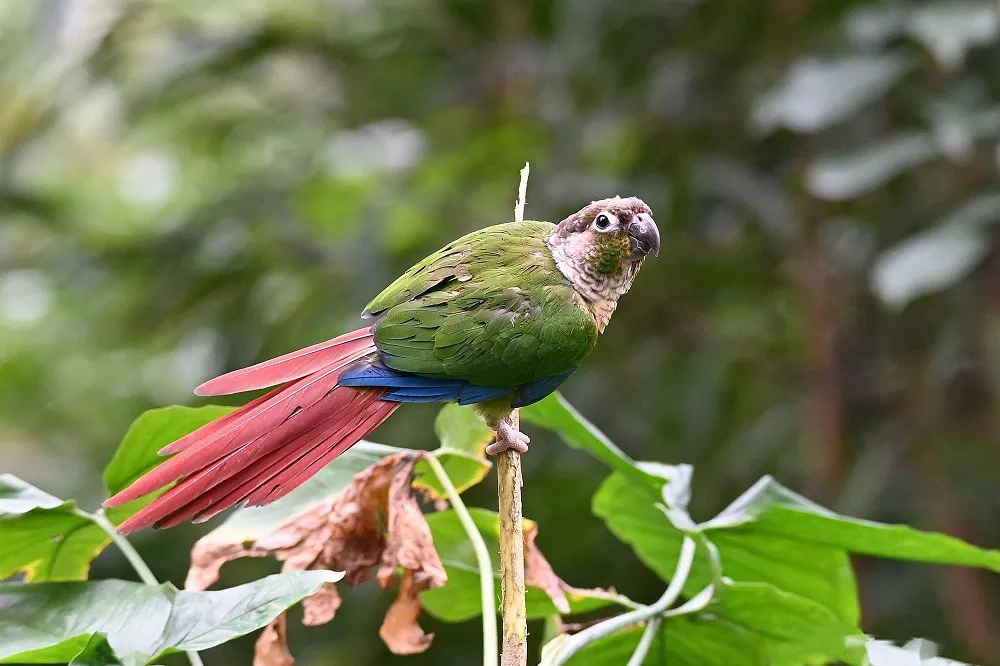Green-cheek Conures are beautiful birds that require a balanced and varied diet to maintain their overall health and wellness. Fruits and vegetables are an essential part of a Green-cheek Conure’s diet, providing them with the necessary vitamins, minerals, and nutrients they need to thrive.
In this article, we’ll explore the fruits and vegetables that are safe for Green-cheek Conures to eat, in what quantities they should be fed, and how often they should be included in their diet.
The Importance of Fruits and Vegetables in Green-cheek Conure’s Diet
Fruits and vegetables play a vital role in a Green-cheek Conure’s diet. They are low in fat and calories but high in fiber and essential nutrients. These foods help maintain healthy digestion, promote weight management, and boost immunity to keep your bird healthy and full of vitality.
Plus, adding fruits and vegetables to your Green-cheek Conure’s diet can also provide some variety and stimulation to their feeding routine, keeping them mentally stimulated and happy.
What Fruits Can Green-cheek Conures Eat?
Fruits are an essential part of a green-cheek conure’s diet, as they are a great source of vitamins and minerals. However, it is important to remember that fruits are also high in sugar and should be given in moderation. Some fruits that are safe for green-cheek conures to eat include:
Apples: Apples are an excellent source of Vitamin C, fiber, and antioxidants. They are safe for Green-cheek Conures to eat, but make sure you remove the seeds and core before serving.
Bananas: Bananas are rich in potassium, Vitamin C, Vitamin B6, and fiber. They are easy to digest and make a great snack for Green-cheek Conures. However, bananas should be given in moderation due to their high sugar content.
Berries: Blueberries, raspberries, blackberries, and strawberries are all rich in antioxidants and Vitamin C. They make great snacks for Green-cheek Conures, but always wash these fruits thoroughly before serving.
Grapes: Grapes are rich in antioxidants, fiber, and minerals like potassium, calcium, and iron. However, they should be given in moderation due to their high sugar content.
Mangoes: Mangoes are a delicious source of Vitamin C, beta-carotene, and fiber. They can be given to Green-cheek Conures, but always remove the skin and pit before serving.
Melons: Watermelons, cantaloupes, and honeydew melons are all safe for Green-cheek Conures to eat. They are rich in Vitamins A and C, fiber, and antioxidants.
Oranges: Oranges are an excellent source of Vitamin C, fiber, and antioxidants. However, they should be given in moderation due to their high acid content.
Papayas: Papayas are rich in beta-carotene, fiber, and enzymes that aid digestion. They are safe for Green-cheek Conures to eat, but always remove the skin and seeds before serving.
What Vegetables Can Green-cheek Conures Eat?
Vegetables are an important part of a green-cheek conure’s diet, as they are a good source of vitamins and minerals. Some vegetables that are safe for green-cheek conures to eat include:
Broccoli: Broccoli is an excellent source of Vitamins A and C, fiber, and calcium. It’s best served cooked and chopped into small pieces to make it easier for your bird to eat.
Carrots: Carrots are rich in beta-carotene, fiber, and Vitamins A and K. They can be served raw or cooked and cut into small pieces.
Sweet potatoes: Sweet potatoes are rich in beta-carotene, fiber, and Vitamins A and C. They are best served cooked and mashed, making it easier for your bird to eat.
Kale: Kale is a superfood rich in Vitamins A, C, and K, calcium, and iron. It’s best served cooked and chopped into small pieces.
Peas: Peas are rich in fiber, protein, and Vitamins A, B6, and K. They can be served fresh or frozen and defrosted before serving.
Spinach: Spinach is a nutrient-dense vegetable rich in Vitamins A, C, and K, folate, and minerals like iron and calcium. It’s best served cooked and chopped into small pieces.
Squash: Squash is rich in beta-carotene, fiber, and Vitamins A and C. It’s best served cooked and cut into small pieces.
Zucchini: Zucchini is low in calories but high in fiber, potassium, and Vitamins A and C. It’s best served cooked and cut into small pieces.
How Much Fruits and Vegetables Should Green-cheek Conures Eat?
Green-cheek Conures should consume a varied diet of fruits, vegetables, and high-quality bird food to meet their nutritional requirements. The ideal ratio of fruits and vegetables in your bird’s diet should be 20-30% of. Ideally, they should be offered a variety of fresh produce each day, including dark leafy greens like kale or spinach, orange and yellow vegetables like carrots or sweet potato, and fruits like apples, bananas, and berries.
It’s important to note that some fruits and vegetables can be harmful to birds, so it’s important to research and consult with a veterinarian before introducing new foods into your bird’s diet. Additionally, any fruits or vegetables offered should be thoroughly washed and cut into small, manageable pieces for your bird to eat.


 Facebook
Facebook  Instagram
Instagram  Youtube
Youtube 